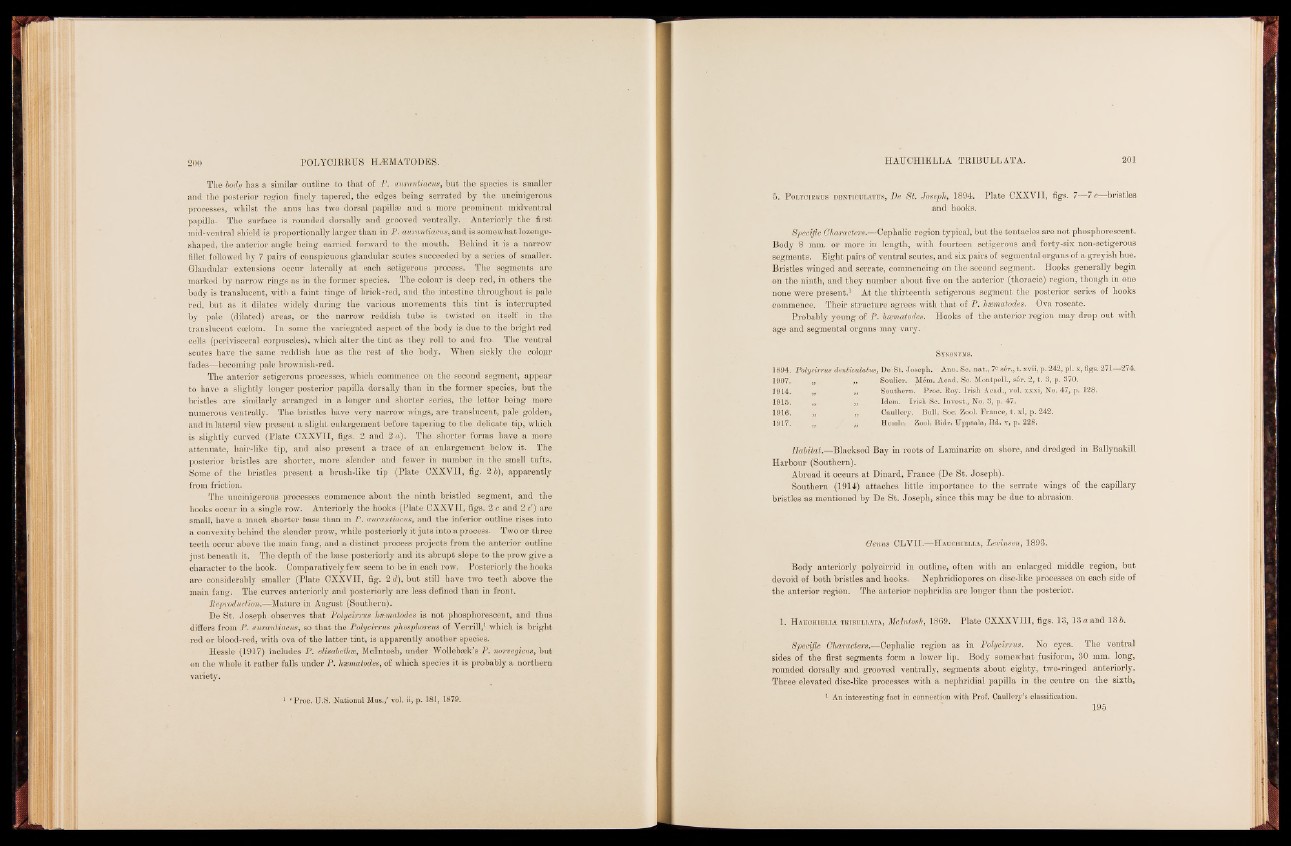
The body has a similar Outline to that of P. aurantiacus, but the species is smaller
and thé posterior region finely tapered, the edges being serrated by the uncinigerous
processes, whilst the anus has two dorsal papillæ and a more prominent mid ventral
papilla. The surface is rounded dorsally and grooved ventrally. Anteriorly the first
mid-ventral shield is proportionally larger than in P. aurantiacus, and is somewhat lozenge-
shaped, the anterior angle being carried forward to the mouth. Behind it is a narrow
fillet followed by 7 pairs of conspicuous glandular scutes succeeded by a series of smaller.
Glandular extensions occur laterally at each setigerous process. The segments are
marked by narrow rings as in the former species. The colour is deep red, in others the
body is translucent, with a faint tinge of brick-red, and the intestine throughout is pale
red, but as it dilates widely during the various movements this tint is interrupted
by pale (dilated) areas, or the narrow reddish tube is twisted on itself in the
translucent coelom. In some the variegated aspect of the body is due to the bright red
cells (perivisceral corpuscles), which alter the tint as they roll to and fro. The ventral
scutes have the same reddish hue as the rest of the body. When sickly the colojir
fades—becoming pale brownish-red.
The anterior setigerous processes, which commence on the second segment, appear
to have a slightly longer posterior papilla dorsally than in the former species, but the
bristles are similarly arranged in a longer and shorter series, the letter being more
numerous ventrally. The bristles have very narrow wings, are translucent, pale golden,
and in lateral view present a slight enlargement before tapering to the delicate tip, which
is slightly curved (Plate CXXVII, figs. 2 and 2 a). The__shorter forms have, a more
attenuate, hair-like tip, and also present a trace of an enlargement, below it. The
posterior bristles are shorter, more slender and fewer in number in the small tufts.
Some of the bristles present a brush-like tip (Plate CXXVII, fig. 2 b), apparently
from friction.
The uncinigerous processes commence about the ninth bristled segment, and the
hooks occur in a single row. Anteriorly the hooks (Plate CXXVII, figs. 2 c and 2 ç') are
small, have a much shorter base than in P. aurantiacus, and the inferior outline rises into
a convexity behind the slender prow, while posteriorly it juts into a process. Two or three
teeth occur above the main fang, and a distinct process projects from the anterior outline
just beneath it. The depth of the base posteriorly and its abrupt slope to the prow give a
character to the hook. Comparatively few seem to be in each row. Posteriorly the hooks
are considerably smaller (Plate CXXVII, fig. 2 d), but still have two teeth above the
main fang. The curves anteriorly and posteriorly are less defined than in front.
Reproduction.—Mature in August (Southern).
De St. Joseph observes that Polycirrus h&matodes is not phosphorescent, and thus
differs from P. aurantiacus, so that the Poly cirrus phosphm-eus of Verrill,1 which is bright
red or blood-red, with ova of the latter tint, is apparently another species,
Hessle (1917) includes P. elisabethæ, McIntosh, under Wollebæk’s P. norvégiens, but
on the whole it rather falls under P. hæmatodes, of which species it is probably a northern
variety.
‘Proc. U.S. National Mus./ vol. ii, p. 181, 1879.
5. Polyoibrus denticulatus, De 8t. Joseph, 1894.. Plate CXXVII, figs. 7—7 c—bristles
and hooks.
Specific Characters.—Cephalic region typical, but the tentacles are not phosphorescent.
Body 8 mm. or more in length, with fourteen setigerous and forty-six non-setigerous
segments. Eight pairs of ventral scutes, and six pairs of segmental organs of a greyish hue.
Bristles winged and serrate, commencing on the second segment. Hooks generally begin
on the ninth, and they number about five on the anterior (thoracic) region, though in one
none were present.1 At the thirteenth setigerous segment the posterior series of hooks
commence. Their structure agrees with that of P. hsematodes. Ova roseate.
Probably young of P. hasmatodes. Hooks of the anterior region may drop out with
age and segmental organs may vary.
1894. Polycirrus denticulatus, De Sfc. Joseph. Ann. Sc. nat., 7e sei\, t. xvxi, p. 242, pi. x, figs. 271—274.
1907.
Soulier. Mém. Acad. Sc. Montpell., sér. 2, t. 3, p. 370.
1914.
Southern. Proc. Roy. Irish Acad., vol. xxxi, No. 47, p. 128.
1915.
Idem. Irish Sc. Invest., No. 3, p. 47.
1916.
Caullery. Bull. Soc. Zool. France, t. xl, p. 242.
1917.
Hessle. Zôol. Bidr. Uppsala, Bd. v, p. 228.
Habitat.—Blacksod Bay in roots of Laminariæ on shore, and dredged in Ballynakill
Harbour (Southern).
Abroad it occurs at Dinard, France (De St. Joseph).
Southern (1914) attaches little importance to the serrate wings of the capillary
bristles as mentioned by De St. Joseph, since this may be due to abrasion.
Genus CLVII.—Hauohiella, Levinsen, 1893.
Body anteriorly polycirrid in outline, often with an enlarged middle region, but
devoid of both bristles and hooks. Nephridiopores on disc-like processes on each side of
the anterior region. The anterior nephridia are longer than the posterior.
1. Hauohiella tjribullata, McIntosh, 1869. Plate CXXXVIII, figs. 13, 13 a and 13 b.
Specific Characters.—Cephalic region as in Polycirrus. No eyes. The ventral
sides of the first segments form a lower lip. Body somewhat fusiform, 30 mm. long,
rounded dorsally and grooved ventrally, segments about eighty, two-ringed anteriorly.
Three elevated disc-like processes with a nephridial papilla in the centre on the sixth,
1 An interesting fact in connection with Prof. Caullery’s classification.